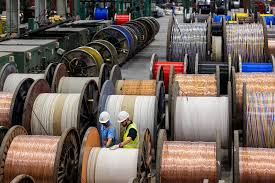In many parts of the world, including seismically active regions like Japan, California, Chile, and even parts of India, the ground beneath our feet is far from static. Earthquakes, even minor ones, can cause significant ground movement, leading to catastrophic damage to infrastructure. For the vital networks of power, communication, and control cables that underpin modern society, deploying them across seismic zones presents a unique and formidable set of engineering challenges. Ensuring these unseen lifelines remain intact and operational during and after an earthquake requires specialized designs, innovative installation techniques, and a deep understanding of geological hazards.
Table of Contents
The Earth’s Fury: Seismic Hazards for Cables
Earthquakes impact cables in several ways, often simultaneously:
- Ground Shaking: The most common effect. Vibrations and oscillations can cause cables to stretch, compress, or snap, particularly at connection points or where they cross fault lines.
- Ground Rupture: If a cable crosses an active fault, the ground can literally tear apart, severing the cable.
- Liquefaction: In areas with loose, saturated soil (like coastal regions or riverbeds), intense shaking can cause the soil to behave like a liquid, losing its bearing capacity. Buried cables can float to the surface, sink, or be severely damaged as the ground moves.
- Landslides & Rockfalls: Earthquakes can trigger landslides or rockfalls, burying or crushing exposed cables.
- Lateral Spreading: Ground movement on gentle slopes can cause large blocks of soil to move horizontally, shearing buried cables.
- Building/Structure Movement: Cables connected to buildings, bridges, or other structures will experience the same movement as those structures, putting stress on entry points and internal routing.
Engineering Resilience: Specialized Cable Designs & Installation
To withstand these forces, engineers employ a combination of resilient cable designs and clever installation strategies:
1. Flexible Cable Designs
- High-Flexibility Conductors: Using finely stranded conductors that can stretch and bend without breaking, rather than solid conductors which are more brittle.
- Elastomeric Insulations & Jackets: Employing highly elastic and tough polymer compounds (like certain rubbers or thermoplastic elastomers – TPEs) for insulation and jacketing that can deform significantly without cracking or losing integrity.
- Loose Tube Fiber Optics: For fiber optic cables, using a “loose tube” design where the optical fibers float freely within oversized buffer tubes. This allows the fibers to move independently of the cable jacket and outer strength members, absorbing strain without breaking the delicate glass fibers.
2. Strategic Installation Techniques
- Slack Loops & Expansion Coils: Instead of pulling cables taut, engineers intentionally create slack loops or “S” shaped expansion coils at strategic points (e.g., where cables enter buildings, cross fault lines, or connect to rigid structures). These loops act as shock absorbers, allowing the cable to stretch or compress without snapping when the ground moves.
- Flexible Conduits & Ducts: Using flexible conduit materials or incorporating flexible joints in rigid duct systems where cables cross active fault lines or pass through areas prone to differential movement.
- Oversized Ducts: Installing cables in ducts that are significantly larger than the cable itself, allowing the cable freedom to move within the duct during ground shaking without being pinched or sheared.
- Gravel/Sand Backfill: For buried cables in liquefaction-prone areas, using specific backfill materials (like gravel or sand) around the cable can help reduce the impact of liquefaction.
- Buried vs. Aerial: The choice between burying cables or running them aerially depends on the specific seismic hazard. Buried cables are protected from wind and falling debris but vulnerable to ground rupture and liquefaction. Aerial cables are vulnerable to falling structures or poles but less so to ground rupture. A hybrid approach is often best.
3. Specialized Connection & Termination Points
- Flexible Connectors: Using connectors and termination points that are designed to accommodate movement and strain without failing.
- Strain Relief: Ensuring robust strain relief mechanisms at all connection points to absorb tension.
4. Monitoring & Data
- Integrated Sensing: For critical infrastructure, integrating fiber optic sensors into cables (e.g., Distributed Acoustic Sensing – DAS, or Distributed Strain Sensing – DSS) can allow real-time monitoring of ground movement or cable strain, providing immediate alerts during seismic events.
The Role of Standards & Collaboration
Designing and deploying cables in seismic zones requires adherence to specialized standards (e.g., IEEE 693 for seismic design of substations, specific building codes). It also necessitates close collaboration between cable manufacturers like leading cable manufacturers in uae, civil engineers, geotechnical experts, and utility companies. The quality of materials from quality cable suppliers in uae must also be certified for these demanding applications.
Conclusion: Wiring for Resilience in a Shifting World
Deploying cables across seismic zones is a complex engineering challenge that demands innovative solutions. By combining highly flexible cable designs with strategic installation techniques like slack loops, flexible conduits, and careful consideration of geological hazards, engineers can build resilient power and communication networks that are better equipped to withstand the forces of an earthquake. As urbanization continues in seismically active regions, the focus on robust, earthquake-resistant cable infrastructure will only intensify, ensuring that our vital lifelines remain intact even when the ground beneath us begins to shift.
Your Seismic Cable Questions Answered (FAQs)
- What is “liquefaction” and how does it affect buried cables?
Liquefaction is a phenomenon where saturated, loose granular soil (like sand or silt) temporarily loses its strength and stiffness due to earthquake shaking, behaving like a liquid. For buried cables, this can cause them to float to the surface, sink, or be severely damaged as the liquefied ground moves and shifts, potentially shearing the cable. - What is a “slack loop” and how does it protect cables during an earthquake?
A slack loop is an intentional, extra length of cable left in a loose curve or “S” shape at critical points (e.g., where a cable enters a building or crosses a fault line). During an earthquake, as the ground or structures move, this slack loop can stretch or compress, absorbing the strain and preventing the cable from snapping or being pulled taut to its breaking point. - Are fiber optic cables more vulnerable than copper cables in an earthquake?
It depends on the cable design and installation. The delicate glass fibers themselves are brittle. However, well-designed fiber optic cables often use “loose tube” construction, where the fibers float freely within oversized tubes. This allows the overall cable structure to stretch or bend without directly stressing the fibers, making them quite resilient to ground movement if properly installed with slack. - How do engineers decide whether to bury cables or run them overhead in seismic zones?
It’s a complex decision based on specific local hazards. Buried cables are protected from wind, ice, and falling debris, but vulnerable to ground rupture, liquefaction, and lateral spreading. Overhead cables are vulnerable to falling poles or structures but less so to ground movement. Often, a hybrid approach is used, or the choice is dictated by the specific geological conditions and urban density. - Are there specific building codes or standards for earthquake-resistant cable installation?
Yes. Many seismically active regions have specific building codes and engineering standards that dictate how critical infrastructure, including cable systems, must be designed and installed to withstand seismic forces. Examples include standards from organizations like IEEE (for substations) and various national building codes that address seismic design for electrical systems.

